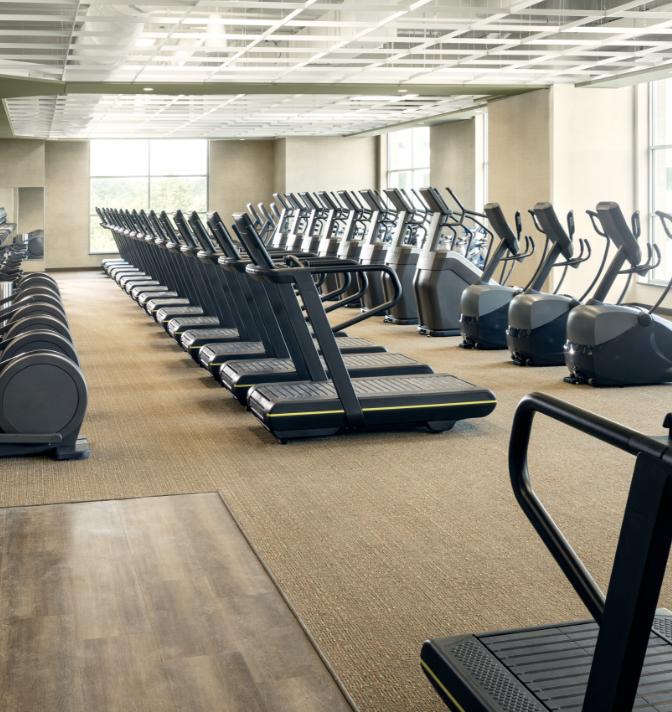If you don’t consider yourself a runner, the prospect of tackling a 5K may seem daunting. But most anyone can do it, and training for this distance is a great way to build solid fitness habits to last a lifetime.
“One of the biggest reasons people stay away from running is that they are somewhat afraid of it,” says Frankie Ruiz, running coach and chief running officer of Life Time’s Miami Marathon. “There’s a certain fear that comes with it because they don’t know enough about it or because they had a bad experience when they were younger.”
The key when beginning a new running routine, he says, is to “focus on time, not distance.” That way, you get to discover your pace and push yourself from there, with leeway to walk as needed — without judgment or pressure to hit a certain mileage goal.
The first step as you get started, says Ruiz, is to honestly acknowledge where you are right now. “One of the biggest mistakes a new or returning runner makes is not recognizing and respecting the true state of their current fitness.”
“We have to assume we are starting from scratch,” he continues. “This means thinking and acting as a beginner even if you are a veteran runner. This is the surest way to stave off injury and ultimately sustain your participation long term.”
Ruiz suggests signing up for a 5K event three months down the road — or at least picking and committing to a date when you’ll run that distance on your own. “When training for a specific event, there is a sense of urgency that is created by an unmovable timeline,” he says, noting that “highlight moments” like races or other events help motivate us as we progress.
“Done right, running can stick with you for the rest of your life and give you so much more life,” he adds. And if there’s any doubt left in your mind, you have permission to “call yourself a runner after that first run.”
Find Your Easy Pace
Running will be more fun if you start slowly. Don’t worry about pace, except to slow down if you feel out of breath. If you’re panting or breathing hard, you’ve gone too long before pulling back; slow down or walk, says Ruiz. (Yes, it’s OK to walk!)
“Go slow — even slower than you think you should be going.”
Running at an easy pace is an important foundational part of training. This refers to low-intensity exertion that helps build aerobic capacity, engages slow-twitch muscle fibers, and helps improve blood flow and oxygenation to the muscles.
Typically it’s an effort level that allows you to have a conversation; if you monitor your heart rate, an easy pace will bring you to about 65 to 75 percent of your max. Combined with training runs at a medium pace (slightly faster) and tempo pace (even faster, but still not a sprint), easy runs will help you progress as a runner.
In addition to your running pace, be mindful of the pace at which you are progressing. Many people push themselves too fast and too hard too soon, says Ruiz. Listen to your body and heed any signals to pull back.
Add Cross-Training
“If you want to enjoy your first 5K — or maybe even set a new record for yourself — I suggest focusing on building leg strength and stamina,” advises Paul Kriegler, RD, LD, CPT, CISSN, a USA track-and-field coach as well as Life Time’s program developer for nutritional products. One of the most efficient and effective ways to accomplish this is quality resistance training.
Kriegler recommends incorporating three strength sessions each week into your workouts. Focus on full-body stabilizing and strengthening moves; be sure to include warm-up mobility movements and cool-down stretches. (For a lower-body workout to complement your running routine, check out “The Workout: Train for the Trail“.)
To balance your running and cross-training workouts, aim to schedule them on different days. Otherwise, perform strength exercises after your hard runs or before your easy runs — and don’t do weight training the day before your speed session or your long run.
Make Time to Recover
Feeling a little tired and slightly sore while training for a 5K is normal. To keep this minimal fatigue from growing into lasting pain or injury, recovery is key.
“Recovery is your chance to repair muscle tissue damaged by resistance training and prepare for the next session,” says Kriegler. “Too often, many people fail to give their bodies either enough recovery time or nourishment to repair.”
Gentle recovery workouts, as well as warm-up mobility and cool-down stretches, help your body recuperate from your last workout and prime you for the next one. (For a restorative workout, see “Back on Track: Restore Your Posture“.)
In addition, Kriegler emphasizes the importance of getting sufficient sleep and consuming an abundance of produce, adequate high-quality protein, essential fats, wholesome carbohydrates, and enough water.
Mind Your Mindset
Running is as much a mental challenge as a physical one, so it’s important to get your head in the game, says Ruiz. That means being honest with yourself about your abilities, meeting yourself where you are each time you lace up, being patient with your progress, and showing yourself some grace.
“Forget where you once were at the height of your fitness, before your break, or as your younger self: Assume you are starting from zero,” he advises. “Focus on simply finishing each workout, not on how fast you’re doing so. Don’t pay too much attention to the speed and level of fitness of other runners. Try to finish every run happy, knowing you could have done more.”
The Plan
The following 5K plan, designed by Frankie Ruiz, is a 12-week program consisting of progressive workouts that combine easy-pace sessions with training techniques like tempo runs, long runs, intervals, striders, and fartleks. (See “Learn the Lingo” further down for definitions of these terms.)
To ease into the program, Ruiz says, start with a walk–run combo for 21 minutes (or walk at a brisk-for-you pace). Build up to doing these sessions five times per week, ignoring the tempo work and long runs noted in the program until you’re ready.
Taking your time to develop your base will serve you down the road. (If you’re new to exercise, consult with your healthcare provider for medical clearance.)
| WEEK | MON | TUES | WED | THURS | FRI | SAT | SUN |
1
|
Easy:
• 21 minutes easy pace • 6 x 20- |
Medium:
• 21 minutes medium pace • 6 x 20-second striders
|
Recovery:
21 minutes easy pace
|
Tempo:
• 5 minutes easy pace • 5 minutes tempo pace • 5 minutes easy pace • 6 x 20-second striders |
Recovery:
21 minutes easy pace
|
Long Run:
30 minutes |
Rest |
2
|
Easy:
• 21 minutes easy pace • 6 x 20- |
Medium:
• 21 minutes medium pace • 8 x 20-second striders |
Recovery:
21 minutes easypace
|
Tempo:
• 5 minutes easy pace • 5 minutes tempo pace • 5 minutes easy pace • 6 x 20-second striders |
Recovery:
21 minutes easy pace
|
Long Run:
• 35 minutes • 6 x 20-
|
Rest |
3 |
Easy:
• 25 minutes easy pace • 8 x 20-
|
Intervals:
• 10 minutes easy run • 6 x 400 meters (3-minute jog/rest between repetitions) • 10 minutes easy run |
Recovery:
21 minutes easy pace |
Fartlek:
• 5 minutes easy pace • 8 x 2 minutes fast, • 8 x 100-meter |
Recovery:
21 minutes easy pace |
Long Run:
• 35 minutes • 6 x 20- |
Rest |
4 |
Easy:
• 25 minutes easy pace • 8 x 20- |
Intervals:
• 10 minutes easy pace • 2 x 400 meters (3-minute jog/rest between repetitions) • 2 x 800 meters (5-minute jog/rest between repetitions) • 4 x 200 meters (3-minute jog/rest between repetitions) • 10 minutes easy pace |
Recovery:
25 minutes easy pace |
Fartlek:
• 5 minutes easy pace • 5 x 2 minutes fast, 1 minute easy • 5 minutes easy pace • 8 x 100-meter striders |
Recovery:
25 minutes easy pace |
Long Run:
• 40 minutes • 6 x 20- |
Rest |
5 |
Easy:
• 25 minutes easy pace • 8 x 20- |
Intervals:
• 5–10 minutes easy pace • 8 x 400 meters (3-minute jog/rest between repetitions) • 5 minutes easy pace |
Recovery:
25 minutes easy pace |
Long Intervals:
• 10 minutes easy pace • 3 x 1 mile (rest between repetitions, at least half the time it took to run 1 mile) • 5 minutes easy pace |
Recovery:
25 minutes easy pace |
Long Run:
• 45 minutes • 6 x 20- |
Rest |
6
|
Easy:
• 30 minutes easy pace • 8 x 20- |
Intervals:
• 10 minutes easy pace • 8–12 x 400 meters (2- to 4-minute jog/rest between repetitions) • 10 minutes easy pace |
Recovery:
25 minutes easy pace |
Long Intervals:
• 10 minutes easy pace • 2 x 1 mile (rest between repetitions, at least half the time it took to run 1 mile) • 2 x 800 meters (rest between repetitions, at least as long as it took to run 800 meters) • 5 minutes easy pace |
Recovery:
21 minutes easy pace |
Long Run:
• 45 minutes • 6 x 20- |
Rest |
7 |
Easy:
• 35 minutes easy pace • 8 x 20- |
Intervals:
• 10 minutes easy pace • 5 x 1,000 meters (4-minute jog/rest between repetitions) • 10 minutes easy pace |
Recovery:
30 minutes easy pace |
Tempo:
• 5 minutes easy pace • 10 minutes tempo pace • 5 minutes easy pace • 8 x 20-second striders |
Recovery or Rest:
25 minutes easy pace (optional) |
Long Run:
• 50 minutes • 6 x 20- |
Rest |
8 |
Easy:
• 40 minutes easy pace • 10 x 20- |
Intervals:
• 10 minutes easy pace • 1 x 1,200 meters (3-minute rest) • 1 x 1,000 meters (3-minute rest) • 1 x 800 meters (3-minute rest) • 2 x 400 meters (2-minute rest between repetitions) • 2 x 200 meters (2-minute rest between repetitions) • 10 minutes easy pace |
Recovery:
30 minutes easy pace |
Tempo:
• 5 minutes easy pace • 10 minutes tempo pace • 10 minutes easy pace • 10 x 20-second striders |
Recovery or Rest:
25 minutes easy pace (optional) |
Long Run:
• 55 minutes • 6 x 20- |
Rest |
WEBEXTRA
4 More Weeks!
| WEEK | MON | TUES | WED | THURS | FRI | SAT | SUN |
9 |
Easy:
• 35 minutes easy pace • 10 x 20-second striders
|
Intervals:
• 10–12 x 400 meters (3 minutes rest between repetitions) • 4 x 200 meters • 10 minutes easy run
|
Recovery:
25 minutes easy pace
|
Fartlek:
• 10 minutes easy pace • 12 x 2 minutes tempo pace (2 minutes brisk walk or medium/easy jog between repetitions) • 10 x 20-second striders
|
Recovery:
25 minutes easy pace
|
Long Run:
• 60 minutes • 6 x 20-second striders |
Rest |
10 |
Easy:
• 45 minutes easy pace • 12 x 20-second striders
|
Intervals:
• 40 minutes easy pace • 12 x 20-second striders |
Recovery:
30 minutes easy pace
|
Intervals:
• 10 minutes easy pace • 5 x 1 kilometer (progressively get faster with each rep; • 3–4 minutes rest between repetitions) • 10 minutes easy pace |
Recovery:
25 minutes easy pace
|
Long Run:
• 65 minutes • 6 x 20-second striders |
Rest |
11 |
Easy:
• 40 minutes easy pace • 12 x 20-second striders
|
Intervals:
• 1x 1 mile (rest as long as it took you to run) • 2 x 800 meters (rest 4 minutes between repetitions) • 2 x 400 meters (rest 4 minutes between repetitions) • 4 x 200 meters (rest 2 minutes between repetitions) • 5 minutes easy pace
|
Recovery:
21 minutes easy pace
|
Tempo:
• 5 minutes easy • 15 minutes tempo pace • 5 minutes medium pace • 12 x 20-second Striders
|
Recovery or Rest:
21 minutes easy pace (or no running) |
Long Run:
• 70 minutes • 6 x 20-second striders |
Rest |
12 |
Easy:
• 35 minutes easy pace • 12 x 20-second striders
|
Intervals:
• 20 minutes medium pace • 4 x 400 meters • 5 minutes easy pace |
Recovery:
21 minutes easy pace
|
Tempo:
• 5 minutes easy pace • 5 minutes tempo pace • 20 minutes easy pace • 6 x 20-second striders
|
Recovery or Rest:
• 21 minutes very easy pace • 4 x 100-meter striders (or no running)
|
5K event of your choice | Rest and celebrate! |
Download the complete 12-Week 5K plan.
Learn the Lingo
Familiarize yourself with these common training terms and techniques to enhance your running experience.
- Tempo Run: Faster than your easy pace, your tempo pace is just past comfortable, one that you could sustain for up to 40 minutes but is fast enough that you couldn’t hold a conversation.
- Intervals: Interval training calls for alternating between work and rest for set amounts of time. “Work” is running at a faster-than-usual pace; “rest” is a slower pace to allow you to recover. While work intervals are not all-out sprints, they are nonconversational and difficult to sustain beyond the interval.
- Long Run: “This is that one element of properly training for a 5K you can’t live without,” says Frankie Ruiz. Once a week, you’ll run a longer-than-usual time (and hence, distance) to build aerobic capacity and confidence. The goal here is to pace yourself by taking a slow and steady pace, and including walking and stretching breaks as needed.
- Fartlek: A Swedish term for “speed-play,” this type of training session alternates between different speeds throughout your run.
- Striders: A strider is not an all-out sprint, but pretty close: Take it a “gear or two below all-out speed,” says Ruiz. Lasting about 10 to 20 seconds, striders are a good time to focus on form. Pay attention to your posture, your arm swing, your cadence, and your knee lift. Take at least one minute of recovery after each strider.





